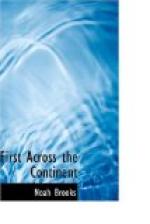The weather rapidly grew so warm, although this was early in April, that the men worked half-naked during the day; and they were very much annoyed by clouds of mosquitoes. They found that the hillsides and even the banks of the rivers and sand-bars were covered with “a white substance, which appears in considerable quantities on the surface of the earth, and tastes like a mixture of common salt with Glauber’s salts.” “Many of the streams,” the journal adds, “are so strongly impregnated with this substance that the water has an unpleasant taste and a purgative effect.” This is nothing more than the so-called alkali which has since become known all over the farthest West. It abounds in the regions west of Salt Lake Valley, whitening vast areas like snow and poisoning the waters so that the traveller often sees the margins of the brown pools lined with skeletons and bodies of small animals whose thirst had led them to drink the deadly fluid. Men and animals stiffer from smaller doses of this stuff, which is largely a sulphate of soda, and even in small quantities is harmful to the system.
Here, on the twelfth of April, they were able to determine the exact course of the Little Missouri, a stream about which almost nothing was then known. Near here, too, they found the source of the Mouse River, only a few miles from the Missouri. The river, bending to the north and then making many eccentric curves, finally empties into Lake Winnipeg, and so passes into the great chain of northern lakes in British America. At this point the explorers saw great flocks of the wild Canada goose. The journal says:—




